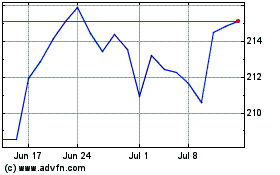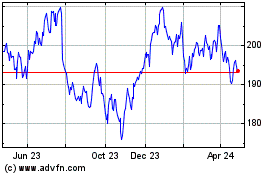Panel Reaches Preliminary Agreement on Airliner Cybersecurity Standards
June 13 2016 - 4:50PM
Dow Jones News
A panel of government and aviation-industry experts has reached
a preliminary agreement on proposed cybersecurity standards for
airliners, including the concept of cockpit alerts in the event
that critical safety systems are hacked, according to people
familiar with the matter.
Some of the recommendations, these people said, incorporate work
already under way to create an entirely new category of automated
in-flight warnings—intended to notify pilots directly if navigation
signals are jammed or corrupted. Such safeguards for ubiquitous
Global Positioning System satellite broadcasts aren't widely
available today, and regulators typically don't mandate them on any
aircraft.
But the proposals envision that these and other provisions would
be incorporated into a broad package of future cyberprotections and
enhanced airworthiness requirements applying to new and existing
aircraft. Commercial and business planes certified in the past
several years already incorporate some more-stringent
cyberprotections, though the recommendations are anticipated to go
further.
The coming report will be the most comprehensive move yet to lay
the groundwork for global regulations combating potential
cyberattacks against aviation.
The advisory group is expected to call for an array of changes
affecting airliners, business jets and even small,
propeller-powered private planes. Creating different levels of
protection for each category, however, continues to be one of the
most challenging goals, and last-minute disagreements could change
the final outcome.
Without spelling out specific security measures or technology,
the recommendations are expected to urge tighter restrictions for
accessing ground-based maintenance computers that routinely
transfer data on and off aircraft, according to people familiar
with the details. Stepped-up controls would extend beyond
determining who can log on to such networks, with experts
considering future additional safeguards for those maintenance
computers connected to the internet, therefore posing greater
intrusion risks.
In addition, the group favors enhanced efforts to ensure the
integrity of software used in laptops, called electronic flight
bags, increasingly used by pilots of commercial, business and
private planes.
The Federal Aviation Administration kicked off the process last
summer amid escalating concerns by plane makers, equipment
suppliers and regulators world-wide about the industry's overall
vulnerability to hackers. There has never been a verified in-flight
incident of unauthorized access to airplane safety systems, but the
topic of verifying incoming GPS signals is steadily attracting more
attention.
"The FAA and aviators are worried, particularly in the past 12
months, about spoofing of GPS," which means sending fake signals to
navigation and flight-control computers on board planes, according
to Matt Desch, chief executive of Iridium Communications Inc., a
commercial-satellite operator with aviation customers. The company
recently introduced a service that "can be used to check a GPS
signal or provide an alternative," he said.
The FAA has instructed panel members not to talk publicly about
their deliberations before an expected progress report during a
U.S.-European safety conference in Washington, D.C., that starts
Tuesday. An FAA spokeswoman didn't respond to requests for
comment.
The advisory group isn't expected to go beyond generic
recommendations, stopping well short of prescribing specific
technical fixes.
The recommendations are being drafted by a federally created
committee with more than three dozen members and observers, ranging
from Boeing Co. and Airbus Group SE to Honeywell International Inc.
to air-safety regulators from Europe and Brazil.
Boeing, which co-chairs the advisory panel along with the trade
association representing small-plane makers, has been blunt about
potential threats.
Mike Delaney, Boeing's vice president of aircraft development
told an industry conference Monday: "You have to worry about the
direct attack, you have to worry about the indirect attack" from
ancillary operations.
Along with U.S. officials, Patrick Ky, Europe's top safety
regulator, has emphasized the importance of ensuring that
air-traffic control systems don't become conduits for bogus
information.
The findings are to be delivered to the FAA in late August,
though translating sweeping, high-level recommendations into
detailed technical standards is likely to take at least a year.
Implementing them will take significantly longer.
Write to Andy Pasztor at andy.pasztor@wsj.com
(END) Dow Jones Newswires
June 13, 2016 16:35 ET (20:35 GMT)
Copyright (c) 2016 Dow Jones & Company, Inc.
Honeywell (NASDAQ:HON)
Historical Stock Chart
From Mar 2024 to Apr 2024

Honeywell (NASDAQ:HON)
Historical Stock Chart
From Apr 2023 to Apr 2024
